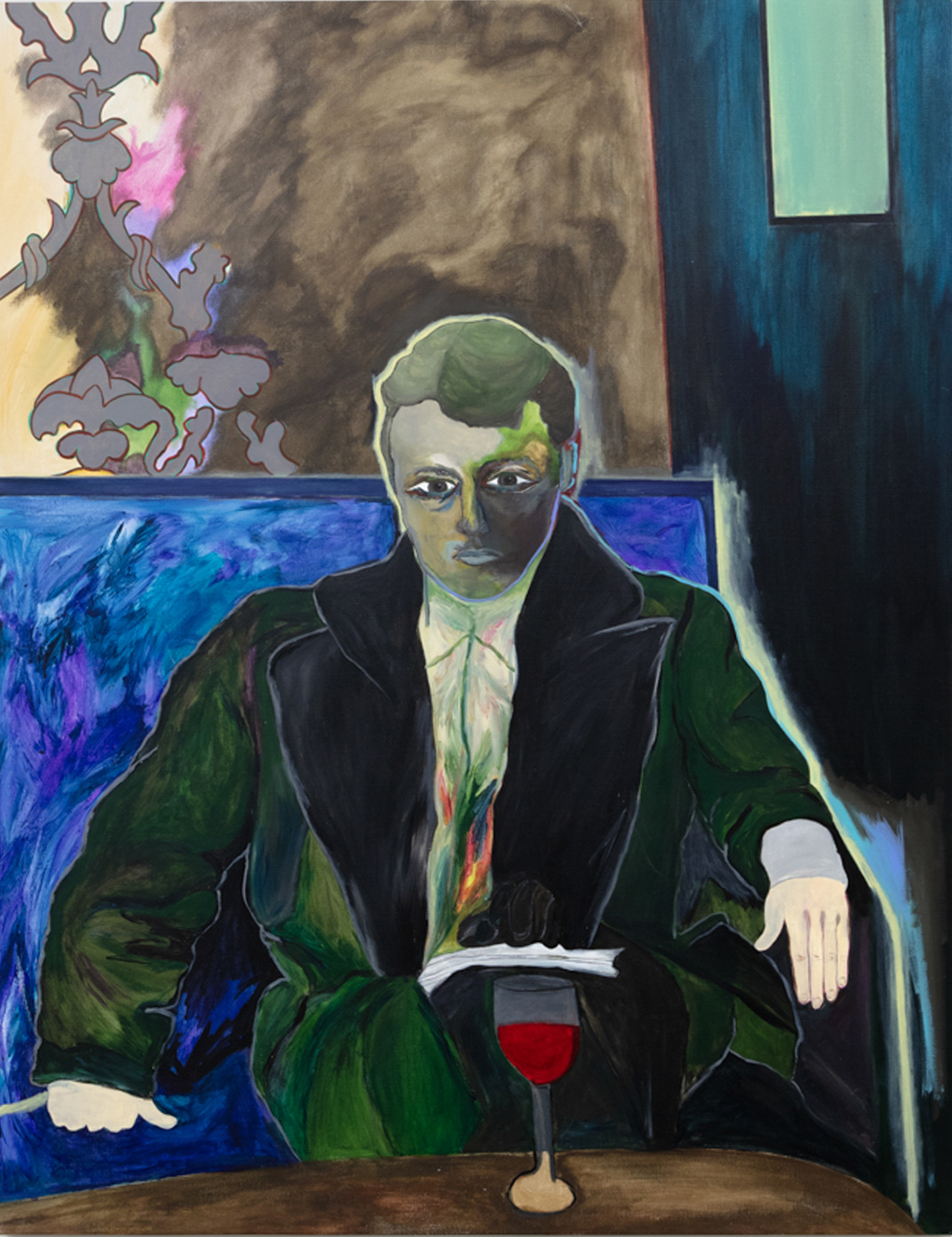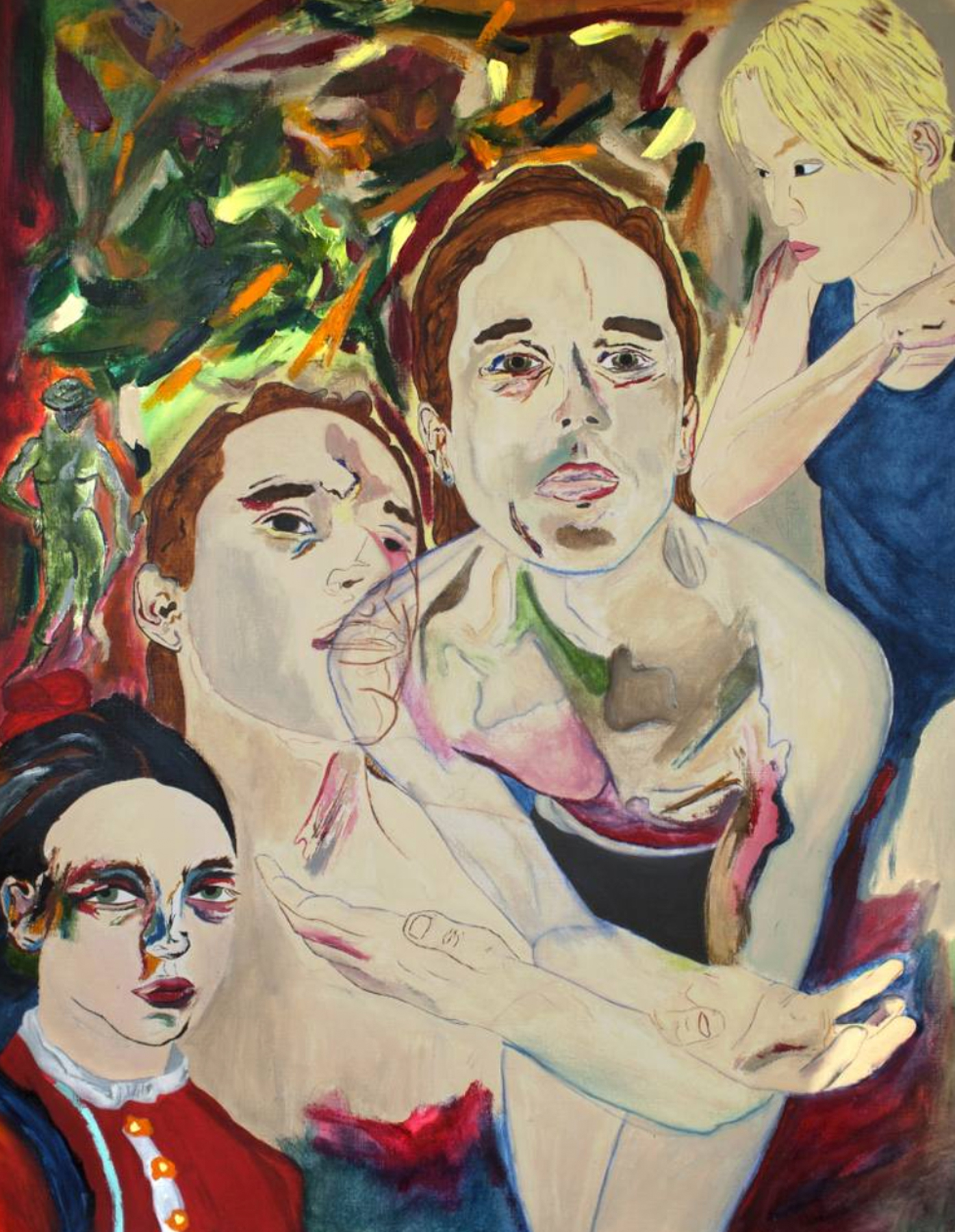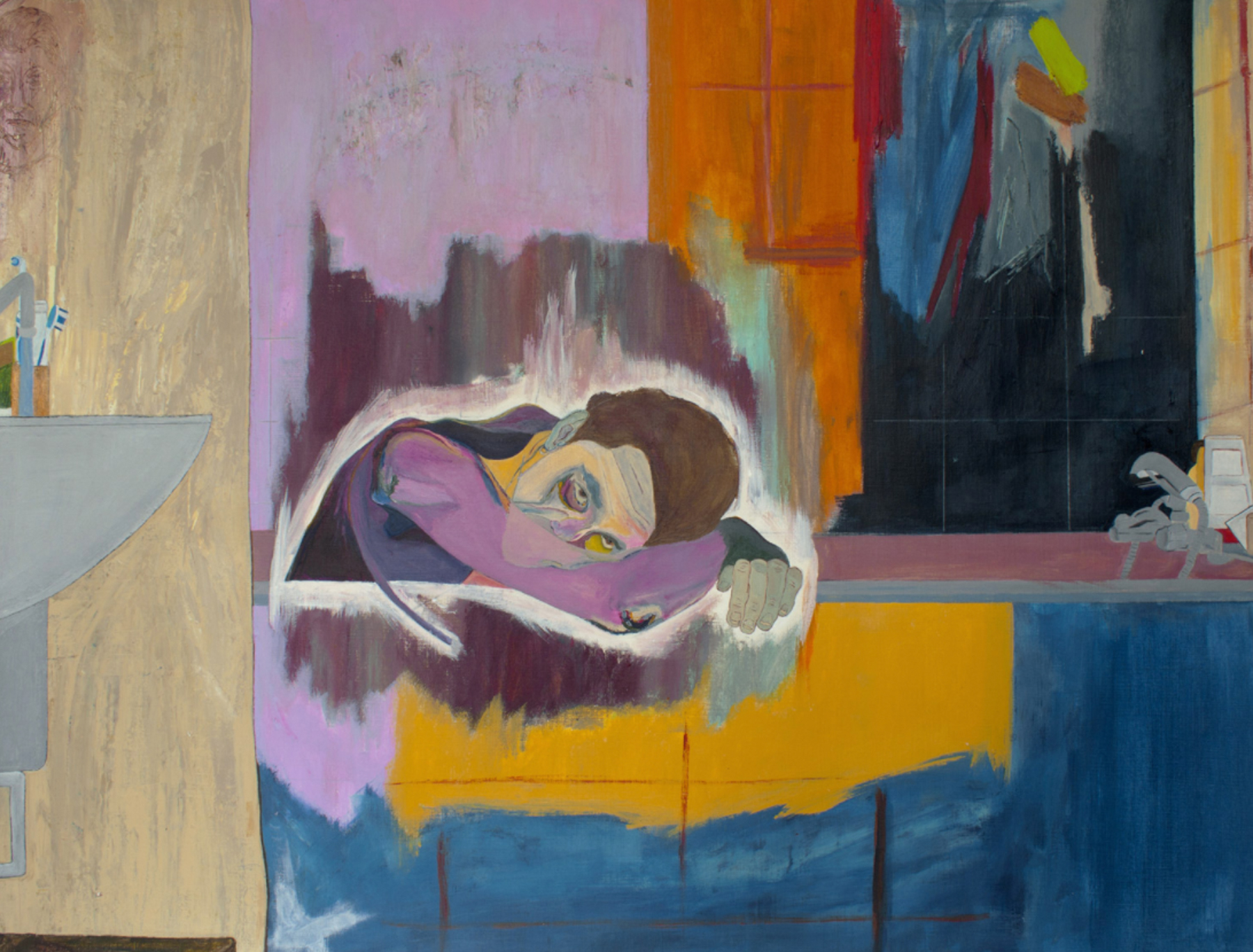From: "Mathieu Bernard Martin"
To: "Hyuna Lee"
Date: Tue 19:47, 3.19.2019Dear Hyuna,
Something like this:
Maisons-Alfort, Paris suburb. Metro line 8. Twenty-five minutes from République, one of Paris main plazas.
The room is open but two massive white birch sliding doors delimit the space. A 140 × 90 cm teak table sits by a white wall. White walls everywhere. Some concrete too. Two large mahogany windows open the wall on its entire width, offering natural light to the occupant. The baking powder factory next door vomits its odor through the same windows. It is warm and outside the trees are bending. Wind blowing strong.In different spots, three masks seem to be staring at me. One of them, I made myself. Papier-mâché. In remembrance of elementary school.
Playing: Andrea Chénier and Jimmy Raney, at the same time. And Coco's purring. A black cat. Princess C. Often, she jumps on my lap or the teak table and hits my face with her tail. Purring mode: still on.
All the painting tools and materials fit in one small yellow storage. On the top of the small yellow storage: books. Valotton's Les paysages de l’émotion, Chagall's Rétrospective 1908 – 1985, Gallimard's not so good La peinture de la Renaissance, Akira's Tome 2, Frtiz Schider's An atlas of anatomy for artists.
Painting portraits affects ego. Better off not painting persons you know.
From: "Hyuna Lee"
To: "Mathieu Bernard Martin"
Date: Thu 03:59, 3.21.2019Dear Mathieu,
The last sentence of your mail (Painting portraits affect the ego. Better off not painting persons you know.), I would love to hear more about that. Does it influence your ego? or portrait model's ego? What does it mean when portraits affect ego? I am also curious about you being cautious about painting someone you know. In your painting, figures sometimes don't look like figures. It almost feels like an extreme emotion transformed itself into a figure. If I imagine all of the figures in your paintings are non-acquaintances, how do you create them? Are they born from emotion or thought? or a scene?
From: "Mathieu Bernard Martin"
To: "Hyuna Lee"
Date: Fri 20:06, 3.22.2019I wouldn't be the one to judge in my ego is affected by my actions, don't you think?
What I meant is that people tend to develop an attachment to their image. That connection to intimate and personal expectations regarding an aesthetic.
I do paint people that I know. They probably just don't know it. Or don’t want to see it. It allows me some freedom in the process. I don't have to be cautious about this at all.
Photography made any visual realism attempt in painting obsolete. Ultra-realism painting is only worth for the master of a technic. For its visual value, it would always be behind the results of a photography.
Intending to paint people the way they look seems a bit foolish. And who cares anyway? The idea is to paint them the way they are. That's the intent.
But you can't be too simplistic when you deal with the creative process. Colors, line, depth, intent, composition, consistency of the painting as a whole, etc. Everything is part of the game. The brain of the artist can be the worst enemy of the art piece.
If you rely too much on preconceived notions_and expectations, you deny the reality of the process. What you may have in mind may not work. Sometimes it just doesn't work. So you have to be focused and open-minded: the fight is tough. The art is stronger than you and once you accept it, it's a step closer to truth.
To be more down-to-earth… Let's say you want to make the portrait of your mother. You know she likes cats. So you want to add a cat on the painting. You think: my mother was a hard worker but at the same time she has always been taking care of her children. So you want to show her in a dignified posture. So you start drawing and painting. But then, maybe the cat on her lap breaks the structure of the image. So you need to fin a new path. Or maybe the cat on her lap is fine. But then, you think that the posture is lacking some strength. And you wonder: what if I take the 'working hard' and 'strong mother' parts, and change the dignified posture into a more defensive or victimized posture?
And probably by the end of the painting, if the painting is not so bad, you reach some kind of truth that your brain could not comprehend. Something more direct. More raw. More organic in a way.
But anyway, the subject of a painting is never a person. It is a character. It is fictional.
From: "Mathieu Bernard Martin"
To: "Hyuna Lee"
Date: Tue 19:47, 3.19.2019현아에게,
대략 이런 식입니다.
파리 교외 메종 알포르 역에 삽니다. 리퍼블리크 광장에서 25분 정도 떨어진 곳입니다.방은 흰색 자작나무 미닫이문을 제외하면 대체로 뚫려있습니다. 흰 벽 옆에 140 × 90 cm 크기의 티크 테이블이 있고, 약간의 콘크리트를 제외하면 사방이 흰 벽입니다. 두 개 커다란 마호가니 창이 한쪽 벽을 채우고, 이 창을 통해 빛이 들어옵니다. 바로 옆 베이킹파우더 공장에서는 늘 똑같은 냄새를 토해내고 있네요. 날이 따뜻해 나뭇가지들은 구부러지고, 바람은 제법 세게 불고 있군요.
각기 다른 방향에서 세 개의 마스크가 제게 시선을 던지고 있습니다. 그중 하나는 유년 시절을 기념하며 직접 만든 파피에 마르쉐입니다.
지금은 안드레아 셰니에와 지미 레이니의 음악이 동시에 흐르고 있습니다. 까만 고양이 코코도 가르랑거리네요. 프린세스 C. 그녀는 자주 허벅지에 올라와 티크 테이블과 제 얼굴을 꼬리로 칩니다.
그림을 그리는 도구들은 모두 노란색 박스 안에 있습니다. 박스 위에는 여러 권의 책이 쌓여 있죠.
브라노 들라루의 <Félix Vallotton: Les paysages de l’émotion>, 마르크 샤갈의 <Rétrospective 1908 – 1985>, 그저 그런 갈리마르의 <La peinture de la Renaissance>, 만화책 <Akira's Tome 2>, 프리츠 스키더의 <An atlas of anatomy for artists>.
어쨌거나 초상화를 그리는 것은 자아에 영향을 미칩니다. 아는 사람은 그리지 않는 것이 좋겠죠.
From: "Hyuna Lee"
To: "Mathieu Bernard Martin"
Date: Thu 03:59, 3.21.2019마티유에게,
마지막 문장에 대해 더 자세히 듣고 싶습니다. 초상화가 자아에 영향을 미친다는 게 어떤 의미인가요? 그림을 그리는 당신의 자아를 말하는 게 아니라면 대상이 되는 모델의 자아를 말하는 건가요? 아는 사람의 초상을 그리는 걸 경계하는 이유는 뭐죠? 마티유의 그림 속 인물은 때로 인물이 아닌 것처럼 보입니다. 극단의 감정이 인물화 된 것 같달까요. 그림 속에 등장하는 인물이 모르는 사람이라면, 당신은 인물을 어떻게 창조하나요? 그림 속 인물이 처음 태어나는 곳은 주로 어떤 감정인가요, 생각인가요? 아니면 장면인가요?
From: "Mathieu Bernard Martin"
To: "Hyuna Lee"
Date: Fri 20:06, 3.22.2019지금 여기서 제 자아에 관해 얘기하는 건 중요하지 않을 것 같은데요. 그건 남들이 저를 평가할 때나 하는 거 아닙니까?
제 말은 사람들은 자신의 이미지에 대해 애착을 보이는 경향이 있다는 겁니다. 사람들은 자기가 예상하거나 바라는 자기만의 미적 기준을 가지고 있으니까요.
네, 저는 제가 아는 사람들은 그럽니다. 그들은 아마 모를 겁니다. 알지만 모른 척 할 수도 있겠죠. 이런 사실이 제게 자유를 줍니다. 전혀 "그들"을 신경 쓸 필요가 없어지는 겁니다.
사실적 묘사를 시도한 사진은 회화를 오래되고 진부한 것으로 만들었습니다. 극사실주의적인 회화는 기술적 장인에게만 가치가 있겠죠. 회화가 시각적 가치를 얻으려면 사진이 줄 수 있는 것에서 멀어져야만 합니다.
누가 사진과 다르지 않은 초상화를 보고 싶어 할까요? 그럴 거면 사진집을 사서 보는 게 낫지 않습니까?
사람들을 있는 그대로 그리려는 시도는 바보 같아 보일 수 있죠. 뭐 그게 의도라면, 누가 신경 쓰겠습니까.
하지만 창조적인 작업을 할 때 지나치게 단순해질 수는 없습니다. 색, 선, 깊이, 의도, 구성, 전체적으로 봤을 때 그림의 일관성… 모든 게 게임의 일부분입니다. 예술가의 생각은 때론 예술 작품의 적이 될 수도 있으니까요.
만약 당신이 선입견에 의존하거나 기대한다면, 과정상의 현실을 외면하고 싶어질 수도 있습니다. 마음에 있는 어떤 생각이 제대로 표현되지 않을 수도, 때로는 실패할 수도 있겠죠. 그러니 집중하고 마음을 열어야 합니다. 이건 만만찮은 일이거든요. 예술은 예술가보다 힘이 셉니다. 이 사실을 한 번 받아들이고 나면, 진실로 한 걸음 더 다가갈 수 있을 겁니다.
보다 현실적으로 얘기해보겠습니다.
어머니의 초상화를 그린다고 가정해보죠. 당신은 어머니가 고양이를 좋아한다는 걸 알고 있습니다. 그래서 그림에 고양이를 넣고 싶습니다.
다음 단계에서 당신은 어머니의 성격을 떠올립니다. 그녀는 일과 육아를 동시에 해내는 강한 사람입니다. 뭔가 위엄있는 포즈를 그녀에게 부여하고 싶을 거예요.
그런데 어머니 무릎에 있는 고양이가 전체적인 구조를 방해하기 시작합니다.
여기서 당신은 새로운 길을 찾아야 합니다. 예를 들어 '열심히 일하는', '강한 엄마'라는 이미지를 가져가기 위해 위엄 있는 포즈를 버리는 겁니다. 대신 조금 더 방어적이고 희생적인 포즈를 선택하는 거죠.
아마 이 과정에 끝나갈 무렵 그림이 그리 나쁘지 않다면 당신은 이해할 수 없는 어떤 종류의 진실을 마주하게 될 겁니다. 더 직설적이고, 날 것이며, 유기적인 무언가.
어쨌거나, 제 그림의 주제는 결코 사람이 아닙니다. 이건 그냥 캐릭터입니다. 허구라는 얘기죠.

















